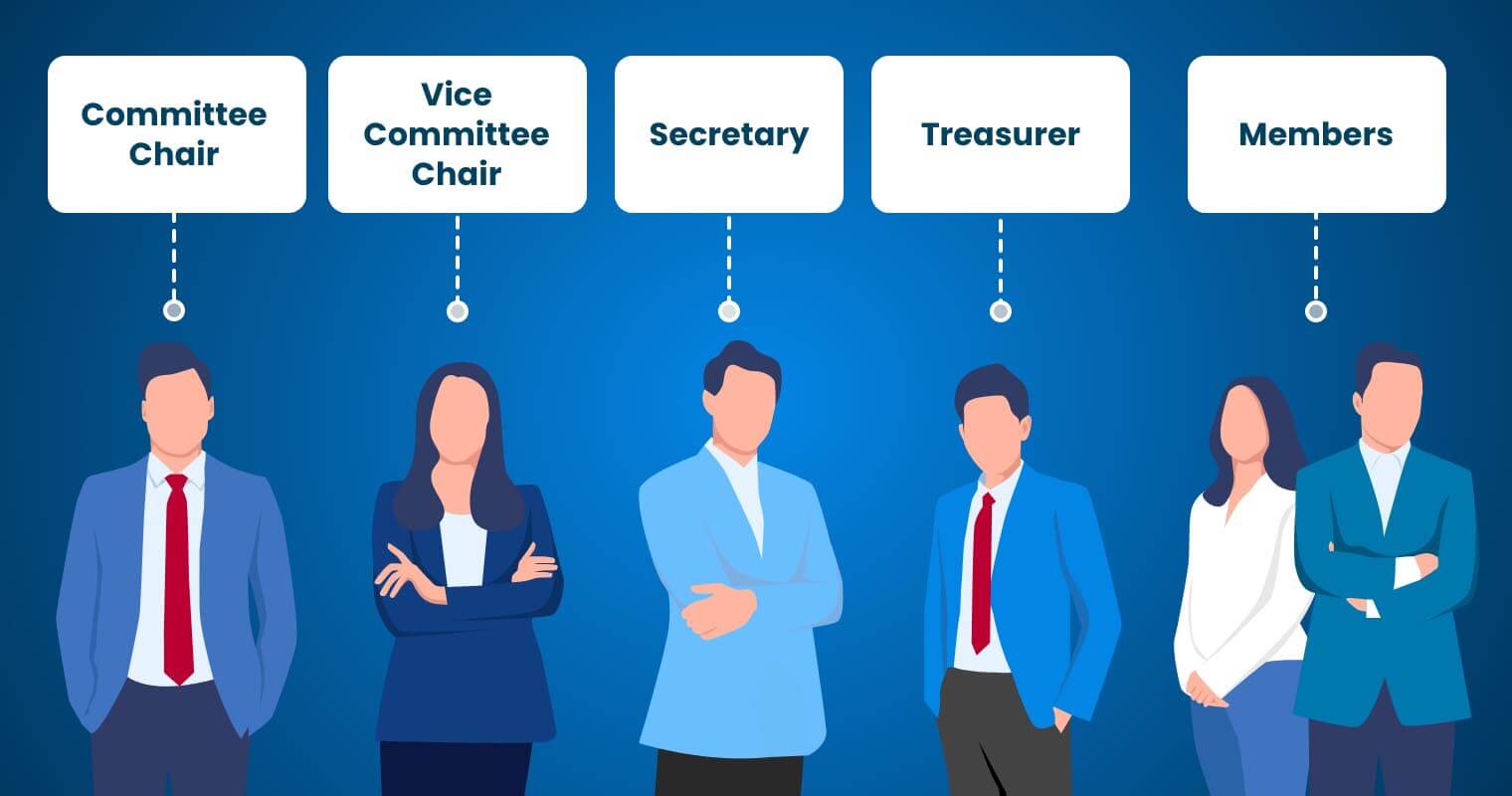Taking a leadership role like a committee chair can be intimidating, especially for those new to management. However, with proper preparation and a positive mindset, aspiring individuals can be set up for success.
To be an effective chair requires a combination of skills, hard work, and determination. Assuming the role presents a valuable opportunity to hone leadership skills and gain insight into the inner workings of organizations when done right.
Want to make sure you’re ready for the role? Read on to learn the committee chair definition, the qualities needed to succeed, and how to effectively resolve conflicts and set goals for the committee.
What is a chair of a committee?
A committee chair is a leadership role in which an individual manages a specific committee assigned by the Board of Directors. Upon assuming the position, the chair receives a committee charter – a document outlining the ultimate purpose of a committee. It guides the committee chair on the committee’s governance structure, enabling them to effectively manage committee members and activities.
How is a committee chair put into position?
A committee chair can either be elected or appointed, depending on the bylaws of an organization. In most cases, a committee chair comes from the members of the Board of Directors. The management can form a nomination committee to identify qualified candidates from the organization. The Board of Directors will then hold interviews and informal discussions before conducting an election or appointing one.
What are the roles and responsibilities of a committee chair?
A committee chair is the backbone of the committee. Without their leadership, the committee can become disorganized and delay project progress. What does the committee chairman do? Below are the key duties of a chairman of a committee to ensure a functioning team.
- Lead and motivate the committee: A committee chair’s primary responsibility is to oversee the entire operations of the committee and enforce governance and accountability. They are responsible for making their members understand the charter entrusted to their committee and how their work contributes to the organization’s goals.
- Liaise between the management or Board and committee: A committee chair is the spokesperson of the Board of Directors to their committee and vice versa. They reduce the gap between committee members and the board, which streamlines information dissemination. Having a representative also helps committee members become more open when sharing their concerns and proposing solutions to the management.
- Spearhead meeting management: Chairing a committee involves organizing and facilitating meetings. Committee chairs and their secretaries manage meetings usually with the help of technology. Modern meeting management tools centralize meeting operations, from drafting meeting packs and notifying attendees to guiding discussions and documentation. More than assisting with meetings, secretaries can use it as a single repository for all documents, making them easily accessible to all committee members.
What are the qualities a committee chair should possess?

Now that you know the committee chairman’s responsibilities, it is also important to understand what qualities are needed to run a committee. An effective committee chair is:
Team Player and Collaborator
A good committee chair motivates the team to do their tasks well and keeps everyone engaged during meetings. The position needs someone who sets the tone for team interactions and boosts trust by promoting respectful communication. They lead discussions and urge participants to be honest and exploratory for the team to produce high-quality concepts.
Good Communicator
The role of a committee chair involves talking and listening. For example, when facilitating meetings where their authority has to be felt, clear and concise communication can help them gain influence over their members. A committee chair should make members feel that their ideas are valid and valuable for achieving their goals.
Decisive
Being successful in guiding and developing teams needs decisiveness. A decisive chair is essential for navigating complex discussions and making informed decisions that push the committee forward. This involves identifying key points, laying common ground, and skillfully guiding the group towards a resolution.
Hesitant committee chairs often encounter analysis paralysis or the inability to make decisions due to overthinking. Such a dilemma may negatively impact members – significantly slowing their progress. Being assertive stimulates timely action, particularly in uncertain circumstances.
Delegation
Leading a team entails managing individuals with diverse roles and responsibilities. A committee chair has to be someone who excels at workload management – a smart planner who schedules and prioritizes tasks based on the capacity and goals of the team.
Being able to delegate effectively is essential when running a team. By strategically distributing the workload, the chair prevents overburdening team members. This empowers individuals to take ownership of their tasks, resulting in more quality outputs.
Impartial
The success of a committee relies on its ability to make well-informed and unbiased decisions. An impartial chair fosters a fair and trusting working relationship where viewpoints are not favored based on personal interests but on factual evidence. Developing this mindset as a team creates a fair space where all members feel confident with their suggestions.
Who makes up a committee?

Committees are crucial components of organizations that stimulate growth. Aside from the committee chair, who else is on the committee?
Committee Chair
A committee chair is the highest-ranking leader within a committee. They directly report to the Board of Directors and are responsible for ensuring that the committee is operating. Moreover, chairs are the signatories on legal and financial approvals before forwarding documents to other teams.
Vice Committee Chair
The vice committee chair plays a crucial role as the right hand of the committee chair. They become acting chairs when their committee chairs are unable to. Typically, an individual is given or elected to this position as a stepping stone to the chair role in the future. Vice committee chairs directly report to the chair, actively assist in supervising members, lead projects, and develop committee policies.
Secretary
The secretary manages administrative tasks within the committee, including documenting all committee activities, maintaining confidential file repositories, and keeping members informed through timely updates. They must be excellent communicators to ensure smooth information flow and liaise effectively with internal and external teams.
A secretary works directly with the committee chair, particularly when managing meetings. They play a hands-on role in preparing meeting documents, sending invites, and following up on tasks after meeting. Secretaries use board portal software to streamline meeting preparation, allowing for faster document turnover and distribution of meeting materials. Leveraging such technology not only increases their productivity but also has a positive ripple effect on the efficiency of the whole committee.
Treasurer
Treasurers help the committee chair oversee the financial activities of the committee. The position requires the treasurer to maintain financial records, particularly for income, expenses, and cash flow. Treasurers play an essential role in promoting financial transparency within the committee by presenting regularly to the officers and members – keeping everyone updated about the financial health of the committee.
Members
Being a committee member is not just about attending meetings; They must contribute to discussions and help achieve the committee’s goals through collaborative decision-making and task completion. Committee decisions are reached by consensus, meaning that all members have an active role in upholding them for the benefit of the organization.
Creating Goals and Objectives for the Committee
A well-functioning committee follows a clear direction initiated by the committee chair. To create impactful goals and objectives, follow these steps:
1. Review and evaluate the current goals
Before creating new goals and paving a new direction, the committee must revisit its current goals first. Facilitating discussion makes it easier to assess and gather ideas on what goals should be worth removing, retaining, and improving – pushing everyone to be critical and see the bigger picture.
The committee chair can start the discussion by asking questions like:
- Does everyone on the committee understand what we are trying to achieve?
- Do our projects and activities reflect our goals and objectives?
- Do our goals and targets reflect our committee’s charge?
- What challenges are hindering us from achieving our goals?
- Should we create new goals and objectives or continue using the existing ones?
- What goals have we achieved in the past years?
- Are the current and new goals of the committee aligned with the organization’s overall goals?
2. Conduct brainstorming sessions
Keep everyone engaged with an open brainstorming session. The committee chair must set the tone for the session and encourage broad thinking to deepen the discussion and unveil more creative suggestions. Remember that ideas must be SMART (Specific, Measurable, Achievable, Relevant, and Time-bound) to make the plans more manageable and easily broken down into actionable steps.
3. Refine goals and objectives
After evaluations and brainstorming, the chair should steer the discussion toward finalizing the goals and objectives. Committee officers should ensure that everything is well-documented to make it easily accessible to all committee members and the board of directors. To establish accountability, follow-up meetings are needed to discuss progress toward the finalized goals and objectives.
How to Navigate Conflicts in Committees
Just like any team, committees face disagreements. But these don’t have to stall progress. Here are a few steps on how to effectively resolve conflicts within committees, and explore the crucial role the chair plays in this process.
1. Ensure a clear understanding of the issue
Everyone should have a shared understanding of the issue through a meeting called by the chair. In the meeting, the chair can conduct a debate to help the parties arrive at a resolution. For some instances where the issue is too complex, the chair can form a subcommittee to guide those involved in discussing and resolving the issue.
2. Comply with Code of Conduct
The committee chair maintains authority throughout the conflict management process and upholds the organization’s code of conduct. Parties involved should follow the established policies to avoid further disagreements and ensure a smoother resolution. The code of conduct is a handbook that outlines rules and policies that members should adhere to such as integrity, objectivity, competence, confidentiality, and professionalism.
3. Voting and declaration
After the discussions, both parties should come to the chair with a proposed resolution for approval. The chair will then present the proposed resolution and open a session for voting. Upon reaching a consensus, the chair will formally declare the decision and call for solidarity.
Increase Efficiency Within the Committee with Board Portal Software

The limitations of physical management are a challenge for leaders like committee chairs to discover ways to achieve equal quality of governance and transparency in both online and offline settings. They need to ensure that every process maintains its integrity and remains well-regulated even with a remote workforce.
Convene’s board portal software, a leading business solution, empowers leaders with a centralized meeting management system that can be used for physical and remote meetings. It is designed to streamline all stages of meeting operations, store committee files securely, and facilitate smooth video conferencing and document sharing.
Convene enhances committee governance with features like Review Rooms for approvals, quick announcements, two-factor authentication for logins, and audit trails to track document sharing – all streamlining committee efficiency.
Drive innovation and boost efficiency within the team with board portal software. Book a FREE Convene demo now!
Jean is a Content Marketing Specialist at Convene, with over four years of experience driving brand authority and influence growth through effective B2B content strategies. Eager to deliver impactful results, Jean is a data-driven marketer who combines creativity with analytics. In her downtime, Jean relaxes by watching documentaries and mystery thrillers.











